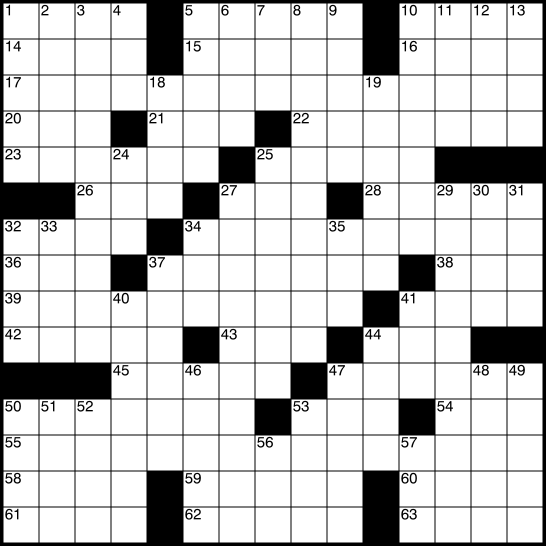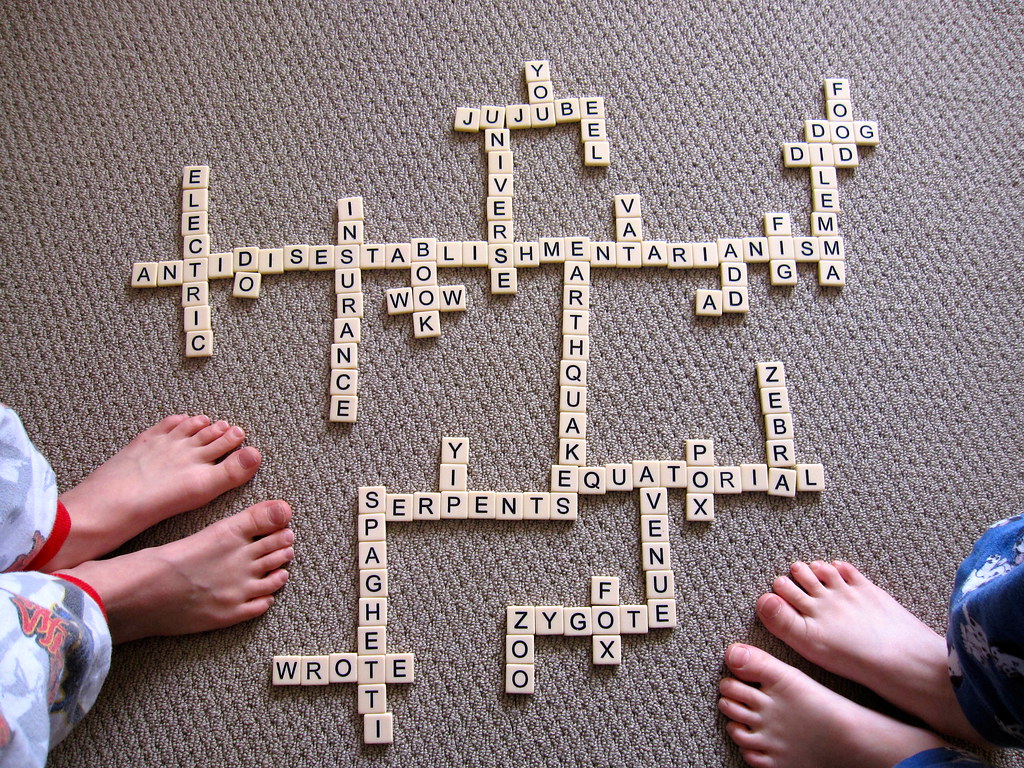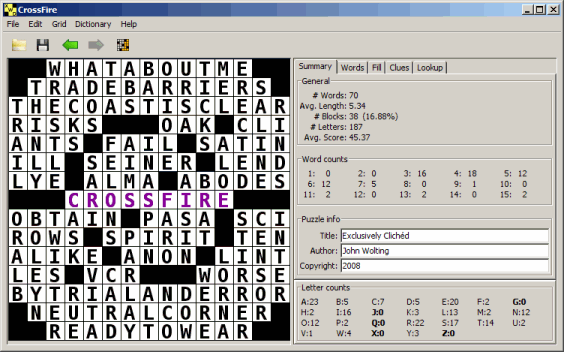Quotes | Summary | Paper | Web | Apps | Which to Use | Examples
Quotes
- "Crossword culture has, however, been shaped by technological, economic, and social forces that
have led women to feel unwelcome, underutilized, and underestimated in its already niche community."
from book: "The Riddles of the Sphinx: Inheriting the Feminist History of the Crossword Puzzle" - "Crosswords, like any art,...
- "Lisa: Guess what, mom? I'm a cruciverbalist!...
- "I think of the indie [crossword] world like...
- "My being a writer and playing Scrabble are connected....
- "crosswordese:...
- Q: What do crossword puzzle editors do to relax?...
- "At the junction of 'across' and 'down'...
- "There is a formal poetry...
- "Complexity can be a trap...
 Summary
Summary
- Crossword constructors create puzzles for many of the same reasons discussed for solvers.
- 'constructors' may be referred to as cruciverbalists, though this often refers to solvers also
- -- or as 'composers', 'setters' or 'compilers' for cryptics in UK / British Commonwealth countries
- This course section introduces construction, broadly and briefly:
- tools: using paper, web sites and apps
- types:
- 1) free-form -- sometimes called 'vocabulary' or 'criss-cross' [above right]
-

American-style grid by Michael J.
via Wikimedia Commons
Attribution-Share Alike 3.0 Unported2) symmetric, fully-crossed, newspaper-style -- 'standard' [on right]
- size: 5 x 5, 15 x 15, 21 x 21, etc.; other shapes
- style: themed or themeless
- A longer course -- Constructing Crosswords -- dives deeper,
with a more focused Approach: - tools: using an app -- not paper or web-based tools
- type, size, style: only 'standard' 15 x 15 themed puzzles
 The overall Process is fundamentally the same for any crossword:
The overall Process is fundamentally the same for any crossword:- Prepare: understand audience; know basic rules;
check publisher guidelines (if submitting);
identify/install tools; dictionaries - Theme: develop and place long theme entries
- Themeless and mini puzzles: seed with several interesting entries.
- Grid: create arrangement of blocks (black squares),
constrained by symmetry, number of blocks and word length;
for free-form, auto-generate grid from word list - Fill: add other 'lively', clueable entries
- Clues: create imaginative/challenging clues while following conventions
- Publish or distribute
- video: How a Crossword Puzzle Gets Made 3:32; Mike Vuolo; Slate; 11/12/2014
- video: How to construct a crossword 2:25; The Passionate Eye: Across and Down; 10/2022
- subsections: References | Examples | Paper | Web Sites | Applications | Which to Use?
References
- How to Make a Crossword Puzzle NYT; 5-part series; 9/2018
- Crossword Constructor's Handbook by Patrick Berry; .pdf; 89pp; $10
- The Art of Crossword Construction by Will Johnston; .pdf; 7pp; free
- How Crossword Puzzles Are Really Made by Matt Gaffney; MF; 9/10/2014
- Course reference sections: Constructors; Dictionaries; Editors; Formats; Publishing; Tools
Examples
- Paper: Merl Reagle Hand-Constructs a Crossword excerpts from WordPlay documentary
- Website: ArmoredPenguin.com: create a free-form puzzle
- Applications:
- Crossword Compiler: free-form (OLLI vocabulary) [below]
- Crossword Compiler: 17 x 17; Beer theme [below]
- Crossword Compiler: Creating a Standard American Puzzle for Publication .pdf
- Crossword Compiler: gallery screenshots
- CrossFire: 5 x 5; CROSS & WORDS [below]
- CrossFire: 15 x 15; NYT: How to Make a Crossword Puzzle [below]
- CrossFire: 15 x 15; OLLI theme [below]
- CrossFire: Walkthrough: Making a 15 x 15 Puzzle
Paper / Manual
- graph paper & pencil, or spreadsheet; dictionary & thesaurus
- general purpose app, e.g., text editor or spreadsheet to layout, save and print a puzzle.
 optional: enter puzzle into tagged text file;
optional: enter puzzle into tagged text file;
import into Across Lite;
export as .puz and nicely formatted .pdf- + ultimate flexibility
- - time consuming to create
- (not recommended)
- Refs: Authoring: MS Office: Word, Excel; Google Docs, Sheets
 Example: "WORD PLAY" by Merl Reagle
Example: "WORD PLAY" by Merl Reagle
- view manual construction from WordPlay documentary @ 0:16:12, 0:19:19, 0:24:44,
0:31:06, 0:38:08, 0:44:50; YouTube excerpt: verifying "REDTOP" - listed in Will Shortz Picks His Favorite Puzzles from his 2011 puzzle collection
- NYT, Tue, 5/31/2005 solution, stats
 Web Sites
Web Sites
- this section covers free-form puzzles using a web-based form
to specify entries, clues, generation & layout options - + simple to use
- + free or inexpensive
- + browser-based (any platform)
- + auto-generate grid layouts; grid grows to incorporate more words
-

Crossword: The kids decided to make one big crossword out of the
bananagram tiles. Interesting choice of words for a 9 and 7 year old!
by CEThompson is licensed under CC BY 2.0+ print; save locally or online?
- - grids fairly sparse; not fully crossed
- - output formats: usually print, sometimes interactive online
- - some may require you to view ads, create an account, or pay for advanced features
- - entering clue/answer info into separate fields can be tedious
- - if import supported, sites may use different formats or separator characters
- AmuseLabs(PuzzleMe): AI Crossword Generation criss cross entries & clues based on a topic
- other AI tools/discussion
-

"crosspassword: correct horse battery staple"
by Steve Weyer
based on Password Strength by XKCD
generated at: armoredpenguin.com;
title of Steve's crosswords pageSome selected sites sites support free-form, vocabulary-style puzzle, esp. for education:
- ArmoredPenguin -- example below; [image: right]
- Class Tools
- Crossword Labs
- Crossword Publisher [image: top right]
- CrosswordPuzzleGames
- Discovery Education
- edHelper
- MyCrosswordMaker; newspaper-style included
- Puzzle-Maker
- Puzzlepad background img; .jpg
- The Teacher's Corner
- Tools for Educators text or image clues from categories
- Variety Games
- WordMint
- Xwords Generator
- Next section will summarize apps for constructing symmetric, fully-crossed, standard puzzles:
browser-based, e.g., Crosserville, Crosshare; stand-alone, e.g., CrossFire, Crossword Compiler.
 Example: ArmoredPenguin
Example: ArmoredPenguin
- Add a Title, Author; many options: square size & shading, etc.
- Enter answers and clues manually?
- Or, edit/save a local text file; each line contains answer:clue
Text file name: Choose File(download demo file);Load Puzzle Make Puzzle- Revise words, clues, layout, etc.? Bkgd: gray; min groups: 1 [image: right]
- Printable PDF (example .pdf), Answer Key, Online, etc.
Applications
- stand-alone apps to construct puzzles, e.g., Crossword Compiler, CrossFire
- see Authoring: Applications section: selected desktop authoring applications & web sites
- + clue numbering; grid generation?
- + dictionary for reference or auto-fill-in
- + create other types of crosswords and puzzles?
- + output in variety of formats: interactive / static web page, .puz, .pdf, .jpg, NYT submission; Word
- + various platforms, i.e., Windows (Win*); Macintosh (Mac); Linux (Lnx); web (e.g., Crosserville, Crosshare)
*if desired app is not 'cross-platform' it may be possible to run it in a VM (virtual machine) on your OS,
e.g., Crossword Compiler (Windows app) via Parallels (VM) on macOS - - learning curve
- - cost for professional features, additional dictionaries and/or software upgrades
Which to Use?
- Some considerations
- style: free-form and/or standard crossword
- purpose: fun, publication, ...
- app & tool platform: Mac, Win, Linux -- or web browser?
- cost
- support
- dictionaries, databases for filling
- output formats: print-only, .puz, web, etc.
- other features?
 What Steve had used until 2018
What Steve had used until 2018
- Constructing (standard, free-form) Crossword Compiler; Authoring: Apps: CC
-- on Mac running Windows via VM: [originally] CrossOver; [later] Parallels - drawbacks: CrossOver incompatibility; system complexity/size;
upgrade costs for Parallels, Windows -- and Crossword Compiler - Interactive web solving: Crossword Compiler applet (JS); other options

What Steve is using now
- Constructing (standard): CrossFire: Mac, Win, Linux; $50 (one-time);
Authoring: Apps: CrossFire - add-on: XWord Info Scored Word List; NYT-only; $50/year ('Angel')
- add-on: Spread the Word(List); free; updated quarterly
- add-on: Cruciverb Word Lists; (unscored) all.txt, nyt.txt; $39/year ('Gold')
- add-on: Matt Ginsberg's Cluer Database App: Mac, Win, Lnx; free no longer updated
- initial grid layouts (based on theme entry lengths): cruciverb.com, crosserville.com
- exploring fill more quickly: Ingrid -- or as a complete alternative to CrossFire?
- Constructing (free-form): free web-based generator (above)
or Crossword Maker For Cruciverbalists (CMFC); iOS; free -- no longer avail - Copy layout to CrossFire (w/ symmetry disabled) for cluing, publishing?
- Interactive web solving: PuzzleMe applet (JS); other options
 Example: Crossword Compiler (CC): Free-form grid
Example: Crossword Compiler (CC): Free-form grid
- Theme words: same demo words as above, w/o clues
- New: Free-form/vocabulary: 15 x 15
- If not enough words fitting,
Size: Two squares larger(increase as necessary),
or prune word list (and start over) - If several grids generated, flip through layouts to pick your favorite.
Accept CC > Clue > Review/edit cluesCC > File > Information: add title, author, etc.CC > File > Export: (many formats, options), e.g., .pdf, .jpg, .puz- optional: import .puz into Across Lite to generate print versions of puzzle & solution (my preference)
CC > File > Web export > Export to Files-- interactive version for a web site
 Example: CrossFire: 5 x 5 (mini)
Example: CrossFire: 5 x 5 (mini)
- Besides CrossFire, you could create same puzzle with free web sites: Crosserville, Crosshare
Create new grid; horizontal: 5, vertical: 5- Add 2 grid squares for a variety of length words: 3, 4, 5
- Place 'seed' (ala theme) words: 1A: "OLLI" (top row); 1D: "OSHER"; 3D: "LEARN" (2nd 'L' column)
- Let's add: "Q" (below 'I'). IQS would be nice but red square warns no letter fits. Unfillable based on current dictionaries!
- Replace with: "Z" -- one letter is only option in 2 squares, i.e., IZE, SUEZ
Grid > Quick Fill-- successful, though with some obscure entries;Undo- Recognize patterns and add words ourselves, or lookup word patterns separately,
e.g., crosswordtracker.com Answer: ?H?AE - I've added some dictionaries to CrossFire:XWordInfo word list and cluer database
- Iterate through
Fill: Best Locationto find better entries. - If unfillable or uninteresting fill, identify problem area.
- For more possibilities, change and/or move seed words to different locations, and/or change grid,
e.g., remove "Z", shift "LEARN", and/or add "SOU" in first column. Grid > Quick Fill?- Fill incrementally, i.e.,
Fill: Best Location - Select recommended (higher score) entry or add your own.
- Next entry -- repeat.
- Write clues
- Review. Publish?
- Other 5 x 5 examples: "Crucigramitas"
Video: How a Crossword Puzzle Gets Made (Vuolo)
How a Crossword Puzzle Gets Made 3:32; Mike Vuolo; Slate; 11/12/2014
Example: CrossFire: (NYT) How to Make a Crossword Puzzle
- featured in: Wordplay 5-part series 4/2018-9/2018
- Part 1: theme two NYT constructors, Ben Tausig and Finn Vigeland,
demystify the process of developing a theme set - Part 2: grid puzzle makers David Steinberg and Natan Last design
a crossword grid around our theme set - Part 3: fill Kevin Der and Paolo Pasco pull back the curtain on the work
that goes into filling a crossword with fun and interesting entries - Part 4: clues Robyn Weintraub and Brad Wilber clue us in;
the submitted puzzle (before editing): web, .pdf, .puz - Part 5: publishing In the final part of this series, the New York Times crossword editors
reveal their process for evaluating and editing a puzzle submission;
resources that were mentioned in this series -- word lists, software, online resources, places to go for questions
-- are included in a single list at the end to assist aspiring constructors
 Example: CrossFire: American 15 x 15; theme: "OLLI"
Example: CrossFire: American 15 x 15; theme: "OLLI"
- Featured in longer OLLI course: Constructing Crosswords
- developing a theme
- designing a grid
- filling-in other words
- writing clues
- publishing or distributing; finished puzzle
 Example: Crossword Compiler: American 17 x 17
Example: Crossword Compiler: American 17 x 17
- Theme: Single Hill Brewing Co. in Yakima, WA
- Theme answers (=7) (after some experimentation):
1@17, 2@15, 2@13, 2@11 letters - Ambitious -- 15 x 15 with 3-4 long theme answers
is more typical, and easier to construct - New: American 17 x 17 grid; Fit Theme Words;
if not all fit, revise list or grid size - Choose most 'open' grid layout (with fewest bottlenecks)
- If Fill options too limited, use additional word lists,
move equal size theme answers to other rows or columns
-- or, revise theme words and repeat - Look for opportunities to add other theme-related words?
- Divide&conquer: identify, close/isolate,
(auto)fill 'hardest/tightest' areas first; write clues; review; ... - Finished puzzle
